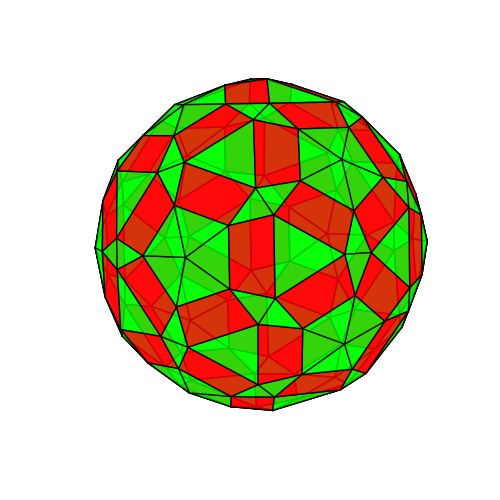
These videos are of 4D objects (regular polytopes) translating through a direction that is perpendicular to our familiar 3.
If you have suggestions for creating videos that involve taking 3D cross-sections of 4D objects please let me know!
#Geometry
#4d
#Video
#600Cell
Easy Math Editor
This discussion board is a place to discuss our Daily Challenges and the math and science related to those challenges. Explanations are more than just a solution — they should explain the steps and thinking strategies that you used to obtain the solution. Comments should further the discussion of math and science.
When posting on Brilliant:
*italics*or_italics_**bold**or__bold__paragraph 1
paragraph 2
[example link](https://brilliant.org)> This is a quote# I indented these lines # 4 spaces, and now they show # up as a code block. print "hello world"\(...\)or\[...\]to ensure proper formatting.2 \times 32^{34}a_{i-1}\frac{2}{3}\sqrt{2}\sum_{i=1}^3\sin \theta\boxed{123}Comments
It's amazing how complicated things can get just by generalizing the 3D icosahedron into the 4D version of it. Wow. The number of parts just explodes: 600 cells, 1200 faces, 720 edges, 120 vertices. Compare that with only 20 faces, 30 edges, 12 vertices of an icosahedron. We are only seeing glimpses of this complexity with this video.
Log in to reply
Yeah. I wish that there were more generalisations of this in higher dimensions though! If you have any suggestions for making more videos on this object let me know.
Log in to reply
First, you need computer animation software, and a way of calculating the geometrical elements. One way is to get some math software to do the latter, and then use the data in a separate computer animation software, as most such animation software do not handle complex mathematical tasks, other than to do the job of modeling, motion, and rendering. Another way is to find a powerful math software package that can do both. Mathematica can do both, but it's not very sophisticated in rendering, i.e., it can't ever compete with movie CGI.
In checking the current CG software market, it's interesting to see that AutoDesk has bought out Alias, and now they have "Maya 7", a pretty sophisticated package that can deliver movie quality animation. In the bad old days, you bought the package anywhere from $20K to $100K, but you can subscribe to Maya 7 for about $123 a month. Still out of range for most people that are not professionals. However, AutoDesk may have something free for students. Check this out AutoDesk
Log in to reply
Apologies, I did not make myself clear! I'm one of the creators of this video (using Python 2). I should've said "Are there any more videos of 3D cross-sections of 4D shapes that anyone would like to see?"
Log in to reply
Wow, you did not make yourself clear! That is quite an accomplishment, to have done this with Python. I know it would have taken me a while using Mathematica. I think this sort of thing could make an excellent series of notes or even wikis. I can think of something right now that you could help with. Have a look at Zandra Vinegar's Hypercube Cross Sections. It seems like most people aren't getting it. I think a note or wiki explaining this would be great.
This is really beautiful work.
Log in to reply
Thanks Micheal, it's part of a project at Uni. Most of the credit should go to my supervisor though! By the way, whenever I take a 3D -cross-section of the 600-Cell it always seems to have square and/or triangular faces. Is this always true and is there an intuitive reason why?
Log in to reply
Just realised the answer! It's because it's made of tetrahedral volumes and a 2d cross-section of a tetrahedron is always a square or triangle (generically)!
Log in to reply
Good observation. I think Zandra Vinegar has another problem about that too, cross sections of a tetrahedron. But it isn't immediately obvious that the 600-cell is made up of tetrahedral volumes---I'd have to stop and think, "Okay, how does a 3D icosahedron generalize to the 4D 600-cell?"
Using the same thinking, we can figure out the correct answer to Zandra's hypercube cross-section problem.
Is there anywhere I can go to learn more about calculating 3d cross-sections of 4d objects?
Log in to reply
Coxeter’s book “Regular Polytopes” is maybe the best place I can think to start if you are interested in regular polytopes. But it does spend a lot of time on geometry and group theory. This really all comes down to linear algebra by seeing where hyperplanes intersect. If you are really interested then feel free to message me with your background info and I’ll try write up a comprehensive note in the future.